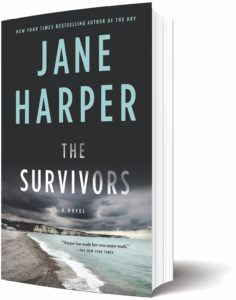If you are in need of a particularly good escape that requires no travel this pandemic February, look no further than Australian crime writer Jane Harper’s latest whodunit, The Survivors, released by Flatiron Books earlier this month. Harper is a minor celebrity Down Under, where her first three mysteries won acclaim and awards. Though her work has garnered praise in the U.S., it may not yet have registered on Outer Capers’ radar. The Survivors will serve as an excellent introduction to her powerful story arcs and beautiful nature writing.

Harper sets in motion an intriguing story from the outset. She begins with a prologue in which two unnamed characters — one male and one female — are in the ocean, seemingly poised on the edge of a first kiss. It’s not clear precisely when or where the action takes place, or why the scene is relevant to the plot. As the novel unfolds, Harper slowly reveals the significance of these details.
Harper quickly gets down to business. She introduces the main character, Kieran Elliott, 30, a physical therapist who has returned from the mainland to his childhood home of Evelyn Bay, a seaside town on Tasmania. With him are his partner and their infant daughter. They have arrived to help Kieran’s parents pack up his childhood home. Though Kieran’s father is physically fit, he is in an advanced stage of dementia and needs more care than Kieran’s mother can provide.
After she’s introduced the main characters, Harper sets up the whodunit. A young art student waitressing in Evelyn Bay is found drowned on the beach. Her murder stirs up memories of Kieran’s older brother’s shipwreck and drowning in Evelyn Bay a dozen years prior, during a freakishly powerful storm. The art student’s murder also churns up an unsolved mystery surrounding the disappearance and assumed drowning of a teenage girl in the aftermath of this same, long-ago storm. Who murdered these two young women? Is there one killer, or two?
The novel’s titular “survivors” are iron sculptures anchored to the entrance to some rocky seaside caves. The three figures are visible except during rare and destructive high tides. The sculptures serve as landmarks and markers as Kieran, a survivor of one of these monster tides, solves the mysteries.
Harper’s characters will likely resonate with Outer Capers. There are plenty of locals devoted to their tiny seaside town, whose off-season population is about 900 and doubles from tourism during the summer. The year-rounders grouse about visitors, who dump trash in the wrong places but also bring much-needed cash. The year-rounders may be in Australia, but their lives will be familiar to Independent readers: they gather for community meetings at the public library, struggle with cutting costs of local services, and hang out at the one restaurant open in all seasons. They also struggle to find paying work so that they can continue to live — and survive — alongside the sea. Aging surfers (male) find work landscaping, fishing, and running deep-sea diving businesses. Women are servers and pick up whatever work they can find.

Harper’s most interesting characters have consistently been male, and this continues to be true in The Survivors. As a teen, Kieran participated unthinkingly in the rites of heterosexual masculinity. When he was a kid, young men in Evelyn Bay were athletic, rivalrous, and destructively competitive. Alcohol fueled their get-togethers. Harper shows Kieran reconsidering old behaviors. When he remembers his first sexual experience, for instance, Kieran recalls that he “had rolled up his sleeves, gone to a party at the beach that very night, and determinedly cast off his virginity in … a joylessly transactional exercise” that was mostly about bragging rights with his friends. As he comes in contact with adult versions of these former friends and grapples with memories of his dead brother, Kieran realizes he has jettisoned these old behavior patterns in favor of raising a daughter alongside a strong, independent partner.
Harper, who has been referred to as the “queen of Outback noir,” is a master of the dry, the wet, and the ugly. Her landscapes crackle with power, driving action more than simply serving as place settings. She set her first novel, The Dry, in a remote Aussie town reeling from the dust and flames of a catastrophic drought. This first novel, arguably her best, was adapted into a feature film released this winter. Similarly, in Force of Nature and The Lost Man, her second and third novels, Harper put her characters in contest with mountainous bush and a remote and punishing cattle station, respectively. In The Survivors, Harper uses language to conjure changing tides, salt-soaked air, and the pleasures and dangers of swimming hard against deep ocean currents. Outer Cape readers will find such settings familiar but also transportive.
The Survivors is an interesting meditation on memory. Harper explores caregivers’ experiences with grief in her frank treatment of dementia and memory loss. In Kieran, Harper has created a male character she holds accountable for past mistakes and who then embraces the possibility that what he accepted as true might actually have been a lie. Harper presents Kieran with variations “he had seen so many times over the years. Similar, but not the same.” Which is how readers who love the Outer Cape may feel about Harper’s representation of life along a fragile coast — simultaneously similar and not the same.



